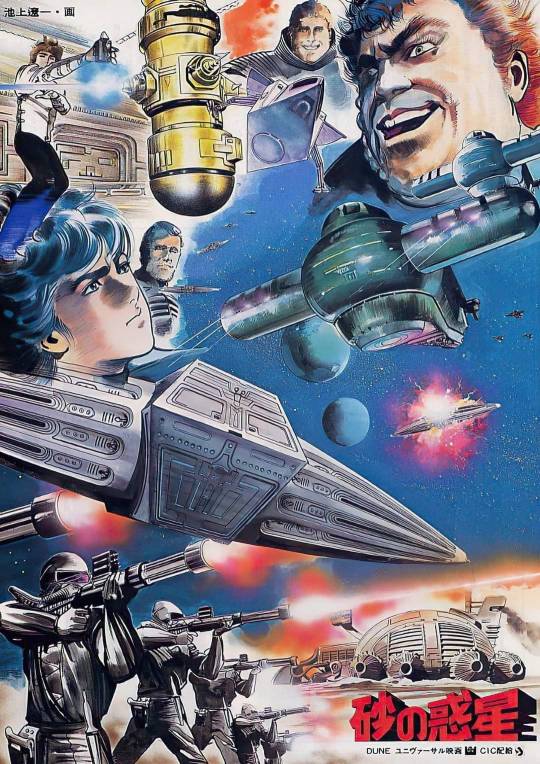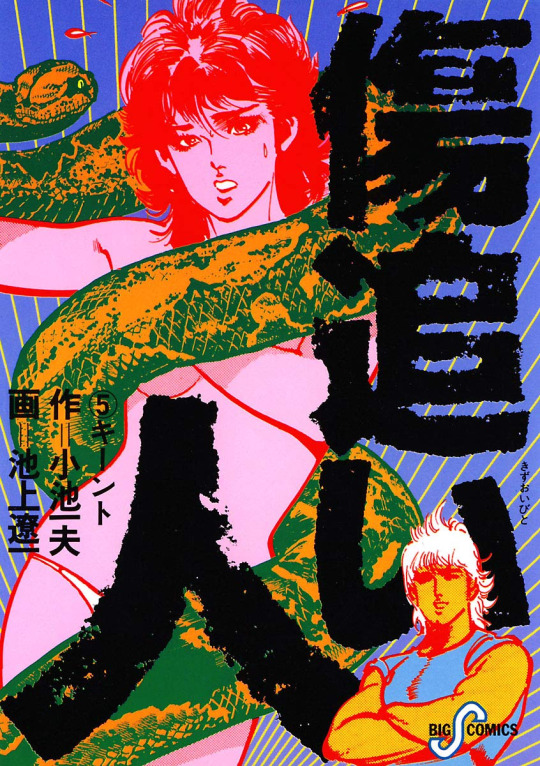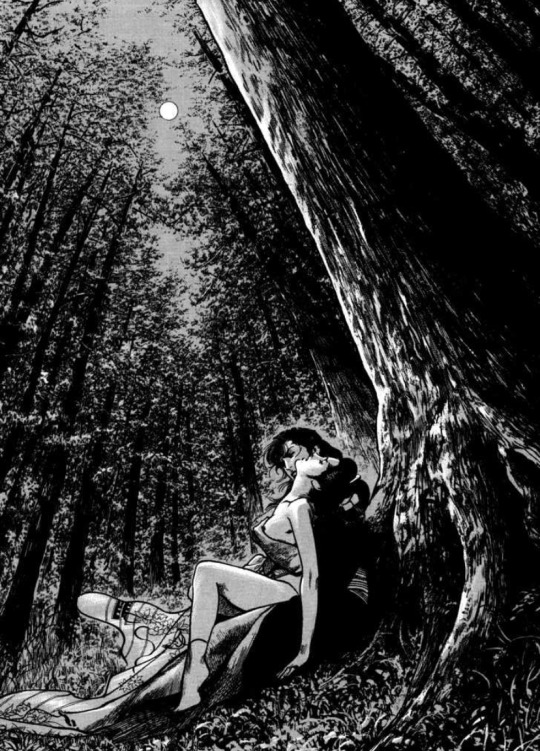#Ryoichi Ikegami
Photo


Crying Freeman — art by Ryoichi Ikegami
983 notes
·
View notes
Text



98 notes
·
View notes
Text

Ryōichi Ikegami - Bestia
2K notes
·
View notes
Text

Ryoichi Ikegami
240 notes
·
View notes
Text

Japanese poster for David Lynch’s Dune by Ryoichi Ikagami.
77 notes
·
View notes
Text



Japanese promotional art by Ryoichi Ikegami for Dune, 1984
569 notes
·
View notes
Text



クライング フリーマン/CRYING FREEMAN
Art by Ryoichi Ikegami
#forgot the chapters so i won't add them in this post sorry#クライング フリーマン#crying freeman#mangaedit#fyanimanga#ryoichi ikegami#*
21 notes
·
View notes
Text



Crying Freeman
by Kazuo Koike and Ryoichi Ikegami
Dark Horse
43 notes
·
View notes
Text

CRYING FREEMAN
Art by RYOICHI IKEGAMI
213 notes
·
View notes
Text











Kazuoibito[傷追い人]: Wounded Man
4 notes
·
View notes
Text
Anime Japan Day One: Trailers and Announcements Everywhere

Anime Japan is always a monster of an event for new anime news, but it's still surprising how much great information they can pack into a single day.
I mean, ten different (good) trailers for series in a single day? It's a mountain of content that's sure to have few entrants slip past fans due to the sheer volume.
Because of that, I've pulled together all of those trailers into a single post! Here, I detail the staff associated with each work, their history, the content of the trailer, and the general outlook that they provide for the series as a whole.
So, whether you're curious about a new series, or unsure of another, the full post serves to help alleviate those feelings!
#new anime#anime pv#anime trailer#anime original#anime japan#anime news#declio's nursery#the grimm variations#clamp manga#clamp#netflix#netflix anime#beastars#dungeon people#atri: my dear moments#turkey!#natsume's book of friends#natsume yuujinchou#natsume yūjin chō#trillion game#ryoichi ikegami#blue box#ao no hako#hibike! euphonium#sound euphonium
5 notes
·
View notes
Photo

Heat — art by Ryoichi Ikegami
327 notes
·
View notes
Text

Spider-Man manga art by Ryoichi Ikegami
31 notes
·
View notes
Text
I was in Grenoble and I missed the Ryoichi Ikegami exhibition ☹️☹️😭😭☹️😭☹️😭☹️☹️
HE WAS THERE PERSONALLY AND HE HELD A DRAWING MASTERCLASS
😭😭😭😭😭😭😭
And I found out about it when I was leaving the city to the station and saw an advertisement!!!!


#ryoichi ikegami#manga#grenoble#manga exhibition#Crying Freeman#Trillion Game#he is misogynist but damn the art is GOOD
16 notes
·
View notes
Text

Bestia Saishi (Part2), Ryoichi Ikegami
2 notes
·
View notes
Text
Mai (a.k.a. Mai, the Psychic Girl)
I am extremely grateful to live in a time where English translations of manga are as accessible as they are. There are plenty of titles I either plan to cover on this blog, or have covered already, that would not have been accessible to me just fifteen years ago. Even if we're only talking about official releases, we are in an era when I can walk into my local Barnes & Noble and buy volumes of semi-recent magical girl titles like Cosmo Familia, Machimaho, and Nirvana. Today I want to take a look back to the beginning of that legacy, and examine what was probably the first magical girl manga ever to get an official English release.

Mai is a 1985 manga written by Kazuya Kudo and illustrated by Ryoichi Ikegami. The story revolves around Mai Kuju, a 14 year old girl with powerful psychic abilities, especially psychokinesis. At first she mostly uses her powers to amuse herself when bored; however, she catches the attention of the Wisdom Alliance, a shadowy organization tracking young psychics worldwide. Mai is one of five teens the Wisdom Alliance has taken an interest in, and once she realizes she's being followed, she has no choice but to go on the run. Encountering danger at every turn, Mai accepts help from those willing to offer it, but when the going gets tough, the tough get psychic.
The story is highly serialized, gradually building on itself and undergoing major status-quo changes along the way. Usually these changes have to do with who Mai's allies are at any given time. One of the things that stands out to me about this manga is the number of people who come to Mai's aid. Ordinarily this kind of character-trying-to-escape-from-a-myserious-group story carries a message of "trust no one", and I was honestly glad to see that subverted here. These supporting characters (usually) don't detract from Mai's story, but reinforce her as the emotional core of the narrative. Oftentimes, Mai's reaction to the events unfolding around her are given as much focus as the events themselves, especially early on. I found this series more compelling than I expected, and even with a chapter count higher than any other manga I've read for this blog yet, it was decently easy to get through. It helps that the chapters were short and well-paced. Lavishly detailed panel compositions draw out the action in some scenes and sell the more tender moments in others.
Not everything about this manga is great though. A content warning is in order for violent and erotic imagery. The violence is used sparingly, and it often conveys the emotional impact and stakes of the narrative, but still, the headsplosions felt unnecessary and caught me off guard. The horny stuff is generally pretty tame, but it does show up more frequently near the end. There's some occasional nudity and inevitable panty shots during the flying scenes, which, whatever, but Mai sustaining outfit damage during the final battle felt completely uncalled for. The political implications of this story are a bit messy as well. Not just in the sense of dated gender relations and gender stereotyping (though there is plenty of that too). The Wisdom Alliance alludes to real-world political systems and historical events in ways that can be hard to parse what the author was implying. They even go so far as to draw comparisons to the Third Reich in terms of the amount of power the Wisdom Alliance holds, which feels questionable. Not to mention, there's some racial stereotyping going on with the psychic kids from other countries. Japanese and white characters in this manga are almost always drawn attractively and/or with realistic proportions, while the Mongolian and Vietnamese boys are... visually distinct let's say. Almost everything about the way they act and talk feels like it's designed to other them, and it's really uncomfortable to read honestly.
The series was co-created by Kazuya Kudo and Ryoichi Ikegami, with Kudo on writing duty and Ikegami drawing the manga. Both worked with Kazuo Koike early in their careers; Ikegami providing illustrations for Koike's 1973 manga I Ueo Boy, and Kudo being one of the first students of Koike's renowned story writing course, Gekiga Sonjuku, in 1977. Both men also worked predominantly in adult-oriented manga with dark and mature themes. From what I can tell, Kazuya Kudo never illustrated any manga, all his stories I know of were drawn by other artists, but he continued writing manga well into the 2000s. Mai is perhaps his best known work, though he is also remembered for Pineapple Army and Nobunaga, the latter of which was also illustrated by Ikegami. Ryoichi Ikegami has been making manga since age 17, and he is still active in the industry as of this writing. Like Kudo, he usually collaborates with other mangaka, drawing rather than writing. One of his earliest works was the 1970 Spider-Man manga co-written by Kousei Ono and Kazumasa Hirai. Three of the manga he drew for have been adapted into OVAs: Kizuoibito in 1986, Crying Freeman in 1988, and Sanctuary in 1996.
Mai was originally published in Weekly Shounen Sunday, a Shogakukan publication, from March 20, 1985 to April 2, 1986, for a total of 53 chapters. The series was reprinted by Shogakukan in six tankobon volumes between July 1, 1985 and July 18, 1986. Media Factory reprinted the series twice in the 2000s, first as three volumes between 2002 and 2003, then as two volumes in 2006. Most recently, Shogakukan published a digital version of the original 6 volumes on April 28, 2020.

But of course, that's only the manga's Japanese run. This series was also translated into Portuguese, Italian, Chinese, and most famously, Mai was among the first manga to be officially published in English. Viz Media collaborated with Eclipse Comics to release the series as Mai, the Psychic Girl from May 19, 1987 to July 12, 1988. Mai (, the Psychic Girl) would prove popular enough with western audiences to warrant multiple reprints, which Viz continued to handle after Eclipse went defunct in 1994. The chapters were compiled into four volumes in 1989 (this time by Titan Books), and a three volume Perfect Collection was published by Viz from 1995 to 1996. Such a widescale release at the dawn of the North American anime and manga boom means that this series is decently well-remembered, seemingly moreso in America than in Japan. (Though that could also have to do with the Japanese title being so nondescript it's difficult to search.)
In fact, Mai, the Psychic Girl was so beloved that there were talks of adapting the manga into a live-action film. This project languished in development hell for decades and ultimately wouldn't see the light of day, despite a script being written and a soundtrack being completed but never released. Over the course of the film's troubled and inconclusive production, it was worked on at different points by Sony, Columbia Pictures, Tim Burton, and Francis Ford Coppola, with Burton expressing interest in the project as recently as 2010. It's unlikely a Mai, the Psychic Girl film will ever happen now, but still, it's kind of a cool side note.
Anyway, back to the manga's English release. I had my concerns going into this, given some of the xenophobic attitudes of the time, and especially because of the tagline on the cover that reads "She is pretty. She is psychic. She is japanese." (Lowercase j? Really?) Thankfully the translation job doesn't seem to lean too heavily into that kind of orientalism. I don't have a secondary translation to compare it to, or a copy of the raw Japanese text, but at the very least the character names are unchanged and the localization team didn't try to hide that the story is mostly set in Japan, in contrast to later and more infamous localizations. There are some nods to American pop culture, such as Mai singing Walk Like an Egyptian by The Bangles in the first chapter, and cameos from recognizable cartoon characters like Snoopy, Garfield, and Mickey Mouse throughout, but from what I can tell, these were in the original. As far as I'm aware, there were only two visual edits made. One was a nude scene being removed from the initial run, which was restored in later printings. The other, and more substantial edit, is that the whole manga is "flopped", a term that refers to the mirroring of pages and panels. Flopping was a common practice in early manga localization given that Japanese books read right to left whereas English books read left to right. Weirdly enough, the flopping here seems a little inconsistent. There were a couple of times I caught details switching sides from one panel to the next. It's not egregious but it is noticeable.
No magical girl manga was officially localized in English before Mai. But I did specify at the beginning that this is probably the first magical girl manga ever to get an official English release. Which raises the question: is Mai even a magical girl manga in the first place? That's... debatable. I talked a little bit about psychic magical girls before in my post on Sennome-sensei, and I stand by the assessment I made in my initial post defining the boundaries of this project that the magic in a magical girl series doesn't have to be literal. It can instead derive from sci-fi or supernatural elements such as E.S.P., so long as the story otherwise meets the criteria of the genre, namely that the story is female led and driven by her using her powers. Therein lies the disconnect with this series. The number of supporting characters in Mai, the Psychic Girl is staggering. That's not a problem in and of itself, after all, many of these characters are pretty fun. Hands down my favorite is Intetsu, a university student with a big heart who might not be a full-on himbo but is at least himbo adjacent. But the sheer number of other characters means there are some chapters, particularly in the middle section, where Mai doesn't appear much. She's still the main character mind you, (no other character gets more focus, and the story manages to continue being about her even in her absence), but it's still a noticeable difference from other titles we've covered. It doesn't help that even when she does show up, there are a couple of stretches of time during which she refuses to use her psychic power to avoid inadvertently hurting anyone. All of this is without even taking into consideration authorial intent: i.e. I doubt the creators intended to make a magical girl manga. Mai, the Psychic Girl draws influence from a lot of different genres. It's an absolute kitchen sink of tropes ranging from martial arts and sword fights to international espionage and government conspiracies. If Kudo and Ikegami wanted to throw in a power trinket or a transformation, it would not have felt too out of place. And yet, this series does not contain any recognizable magical girl signifiers of the time, nor does it draw any influence I can identify from magical girl works that came before it. That's just not the kind of story they were trying to tell.
But despite everything I just said, there are plenty of moments in this manga that feel magical girl-esque somehow. There are certain narrative and visual cues that are not exclusive to the magical girl genre, but are still very prominent within it, which do show up in Mai in some capacity. For one thing, Mai has a puppy named Ron which spends so much time with her, he ends up developing latent psychic abilities of his own. This manifests as extrasensory perception of danger, which he uses to warn Mai of incoming threats, much like some mascot characters do in certain later magical girl works. Mai also has two best friends (named Yumiko and Rie) who are average schoolgirls from whom she has to keep her double life a secret. I was actually pleasantly surprised by how often they reappear in the story, as they and Mai genuinely care for one another, and their friendship very effectively establishes that despite her abilities and the danger she consistently finds herself in, Mai is an ordinary girl. Speaking of how Mai relates to others, the Wisdom Alliance eventually calls in one of the other teen psychics, a German girl named Turm Garten, to help eliminate Mai. A major story arch revolves around the one-sided rivalry between Turm and Mai, the latter of whom just wants to be friends, and it's very much evocative of the dark magical girl archetype. I also feel the need to point out that the series starts with Mai having a prophetic dream, something that jump starts the plot of a few high profile magical girl works. And lastly, we find out early on that in the Kuju family, psychic powers are passed down matrilineally. Mai comes from a long line of female protectors, and this revelation influences the way she thinks about her destiny.
Mai, the Psychic Girl is a mixed bag in just about every way. Some aspects of it are deeply artful, other aspects are atrociously tacky. There are things about it that have aged like milk, and yet it does boast some historical significance. I like it for what it is, even if it's not my usual cup of tea. It's not what one might expect from a magical girl manga, but if you enjoy magical girl stories, you might enjoy this.
#my posts#long post#Mai#Mai the Psychic Girl#舞#Kazuya Kudo#Ryoichi Ikegami#工藤かずや#池上 遼一#Weekly Shounen Sunday#80s#shounen#official English translation#dubiously magical girl#Extremely thankful I was able to get this out before the end of the month.#Sorry the wait was longer than expected.
13 notes
·
View notes